#Botanical Garden of Rome
Explore tagged Tumblr posts
Text

Giovanni Battista Ferrari
Flora overo cultura di fiori, Rome, 1638
Sotheby's
17 notes
·
View notes
Text


Corner of a pond in the Japanese garden of the Orto Botanico di Roma 4/10/2024
#cannot tell if i like this one#art#my art#drawing#sketch#plein air#drawing from life#cherry blossoms#japanese garden#japanese lantern#japanese pond#orto botanico di Roma#botanical garden#nature#sennelier ink brush#ink brush#marker drawing#marker sketch#Roma#Rome#Italy#Italia
1 note
·
View note
Text
It supposedly lights up red, green and white for the Italian flag
Do not have time to see it at night though sadly
Is it an actual aid to navigation? No
But still
Lighthouse!


#most ppl go to rome and see the coliseum or vatican#i go to rome and see the Italians of argentina memorial lighthouse and the botanical gardens#yeah yeah i also saw the vatican and coliseum#this was much more fun though
6 notes
·
View notes
Text
My mom and I have taken two tour-group style outings for day trips outside of Amsterdam. I haven't loved either of them, but there were still things to enjoy about each. They both reminded me of that quote from A Room With a View:
We residents sometimes pity you poor tourists not a little - handed about like a parcel of goods from Venice to Florence, from Florence to Rome, living herded together in pensions or hotels, quite unconscious of anything that is outside Baedeker, their one anxiety to get 'done' and 'through' and go somewhere else. The result is they mix up towns, rivers, palaces in one inextricable whirl.
As hard as we tried to select options with plenty of free time to explore on our own, the logistics of a group tour feel very impersonal and almost time squandering. And the tour groups by design take you to the most touristy places. Theoretically, tour guide help make the experience more interesting, but most of the information is very superficial, nothing a quick internet search wouldn't tell you.
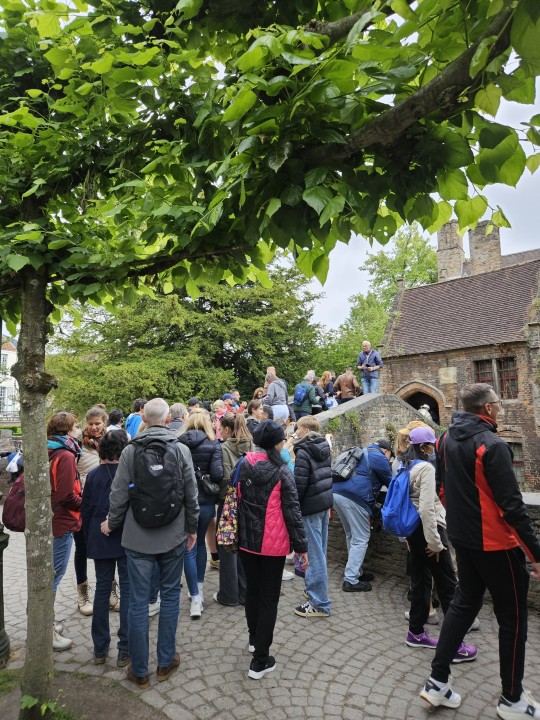
The above photo is from our day trip to Bruges. The tourists (ourselves included) were like ants crawling all over the city. It felt like Disneyland rather than a medieval Belgian city. Hard to appreciate what a special place it is.
On both of our tours, we befriended a solo traveler. I mentioned to mom that as a person who really enjoys solo travel, I don't think I would ever go on one of these excursions alone. I was having a really hard time explaining why.
It's not like these places aren't beautiful or worthy of seeing just because you're traveling alone. And surely there is a convenience in having someone arrange all the transportation for you. But for me the joy of solo travel is the insane amount of freedom I have to do and see whatever I want. And you just don't have that kind of freedom on these tours.
I like taking in a city by wandering around on my own, stopping when I see something interesting and looking it up online. Or following a walking tour at my own pace. Stopping for coffee and just people watching for a while. Learning the neighborhoods and enjoying them. This is a particularly nice thing to do in cities with good public transit or small city centers where I can really roam safely at my own leisure. I like starting in the tourist centers and radiating out. Going to a park or a botanical garden, hitting the museums.
I'm glad I got to see Bruges and Giethoorn, but I probably would never travel this way again.
39 notes
·
View notes
Photo

On this day, 6 July 1921, the Arditi del Popolo, an early militant anti-fascist organisation, had its first official public rally in the botanical garden in Rome, Italy. The police reported that 15,000 people were in attendance, and that "there were numerous red and black flags", whereas the press reported between 30,000 and 70,000 attendees. Arditi was the name of the Italian army special forces unit in World War I, so the name "Arditi del Popolo" meant "People's Arditi". On July 6 they formed themselves into three battalions of 1000 fighters each, with the purpose of defending workers from violent attacks by the fascist blackshirts of Benito Mussolini. After the rally there were some clashes and shootouts between the Arditi, fascist squads and the police, during which 10 people were wounded and some Arditi members were arrested for weapons possession. The group brought revolutionary trade unionists, anarchists, communists, and socialists together, and within its first year it had grown to include over 100 offices and 20,000 members. We are putting the finishing touches to a podcast miniseries about the resistance to fascism in Italy, in conversation with surviving partisans. Support us on patreon to help us cover the cost of its production, and get early access to listen to it: https://patreon.com/workingclasshistory https://www.facebook.com/photo.php?fbid=656769369829615&set=a.602588028581083&type=3
113 notes
·
View notes
Text










honeymoon;
p a r t . t h r e e
Day five Thursday July 4
We sleep in. Today is our last day in Rome. We wait in line for the greatest pizza in the world at Piccolo Bucco; the ingredients are fresh and the burrata (cream encased with mozzarella) on top is a culinary breakthrough. We see the (outside only) Pantheon ~25 BC originally built as a tribute to the twelve gods, and reconstructed ~118-125 AD as a Catholic church; it is so incredible, Cody appears to be inserted by photoshop when photographed in front of it. We walk through the botanical garden, which my husband thoughtfully included in our itinerary just for me. We eat at a Michelin rated restaurant, Antico Arco; we buy an outrageously expensive, 20 year aged bottle of wine; greater amberjack ceviche with sweet potato mousse was my personal dish; Cody orders the black truffle carbonara and filet mignon; the kitchen generously gifts us small dishes throughout the meal; the dessert is so extraordinarily fancy, it is too difficult to describe; everything was….incredibly perfect. We return to the speakeasy where a local tells us the linguistic origin of Sacramento. We walked over 50 kilometers during our time in Rome.
5 notes
·
View notes
Text
The Oldest Treasures From 12 Great Libraries

The oldest reading room at the Bodleian Library, in Oxford. David Iliff/CC-BY-SA 3.0.
When you start to think about the oldest books that a library might hold, there are any number of rabbit holes you can fall down. What’s the oldest book in any particular city? What’s the oldest book in the world? Well, what do you mean by “book”? The oldest written text? The oldest manuscript? The oldest printed material? The oldest bound book?
Librarians take these kinds of questions very seriously, so when Atlas Obscura contacted some of our favorite libraries to ask about the oldest books in their collections, we were treated to a wealth of information about the treasures they hold.
The New York Public Library, for instance, has not only cuneiform tablets and ninth-century gospels, but also a Gutenberg Bible and a copy of The Bay Psalm Book, one of the oldest books printed in America. In addition to its own cuneiform tablets and Gutenberg Bible, the Library of Congress holds one of the oldest examples of printing in the world, passages from a Buddhist sutra, printed in A.D. 770, as well as a medieval manuscript from 1150, delightfully titled Exposicio Mistica Super Exod.

New York Academy of Medicine
Apicius, De re culinaria
Created: A.D. 830, Germany
Synopsis: The earliest surviving cookbook in the West, this Latin manuscript contains recipes that date all the way back to the fourth century B.C. These were recipes meant for average Roman households, although they included non-native spices that would have had to travel far to reach the Mediterranean. Some of the highlights, according to the library, are “roast lamb with coriander, deep-fried honey fritters, and cucumber with mint dressing.”
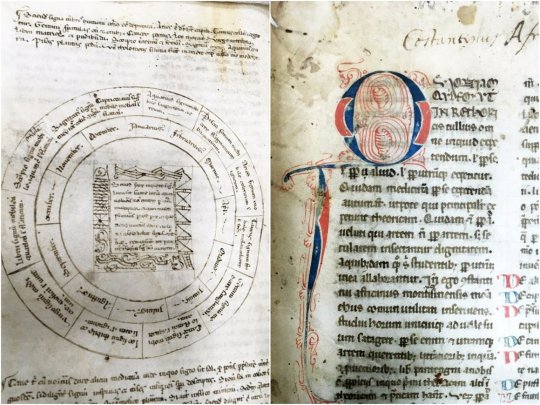
The College of Physicians of Philadelphia
Constantinus Africanus, Viaticum
Created: No later than 1244, Italy
Synopsis: In the 10th century A.D., Ibn al-Jazzar, an Muslim physician, wrote a book titled Provisions for the Traveler and the Nourishment of the Settled, a compendium of the medical knowledge of the day, which focused on the interaction of humours and elements in the human body. A few decades later, Constantinus traveled from North Africa to a monastery in southern Italy, where he adapted and translated Ibn al-Jazzar’s work into Latin.

Bodleian Library
Ash-Preserved Papyrus
Created: Before A.D. 79, Herculaneum, Italy
Synopsis: When Mt. Vesuvius erupted in the first century A.D., it covered the town of Herculaneum in ash, gas, and other volcanic material that preserved organic matter for hundreds of years. These carbonized papyrus scrolls came from the town’s library. Archaeologists have struggled to find a way to read the damaged scrolls, so there’s little known about their contents—though progress is being made with advanced imaging techniques.
Provenance: These scrolls were discovered in Herculaneum in 1750s. In 1810, George, Prince of Wales, received 18 of them and presented four to the library in Oxford as a gift.
St. Catherine’s Monastery
Codex Sinaiticus
Created: A.D. 330–60, possibly Rome, Italy
Synopsis: A handwritten version of a Greek Bible, the codex is one of the oldest copies known today, and the oldest surviving version of the complete New Testament.

Chicago Botanic Garden
Theophrastus, Historia Plantarum
Created: 1483, Treviso, Italy
Synopsis: Back in the third century B.C., Theophrastus, one of the first botanists of the Western world, set out to catalogue the the plants of ancient Greece and created the first known classifications of plants in his part of the world. He covered a range of trees, shurbs, dwarf shrubs, and herbs and examined how they grew and were used in his own time.

American Museum of Natural History
Albertus Magnus, De animalibus
Created: 1495, Venice, Italy
Synopsis: Albertus Magnus spent his life studying and commenting on the works of Aristotle. Without his work, much less knowledge of the Greek philosopher would have made it to future generations of scholars. Albertus, who died in 1280 and was later canonized, wrote widely about the scientific and natural worlds. This volume collects his work on the animal kingdom.

Library of Congress
Cuneiform Accounting Tablets
Created: 2050 B.C., Sumeria
Synopsis: The Library of Congress’ oldest written material dates far back, beyond the founding of this nation, to more than 4,000 years ago. The collection of cuneiform tablets dates back to the reign of Gudea of Lagash, in the 2100s B.C. The tablets recorded bills of sale, receipts, ledgers, and other accounting tasks.

Folger Shakespeare Library
Magna Carta
Created: Compiled 1325, England
Synopsis: The Magna Carta was the first English statute, but it wasn’t given that name until after 1217, when it started being issued along with the Charter of Forests. To distinguish the original statutes from the forestry code, they were given the name the Great Charter, or the Magna Carta. This copy is in Anglo-Norman, translated from Latin.

Boston Athenaeum
Egyptian Artifact Album
Created: circa 1500 B.C., Thebes, Egypt
Synopsis: This book isn’t exactly the oldest book in the Athenaeum’s collection. It was bound in the 1910s and is “more an album of archaeological artifacts than a rare book in the traditional sense,” the library writes. It contains three shrine hangings describing the worship of the goddess Hathor, and a series of inscribed mummy bandages, which are some of the oldest examples of painting on cloth.

Austrian National Library
Book of the Dead
Created: 15 century B.C., Egypt
Synopsis: Sesostris was a cattle counter and writer in ancient Egypt, and he was well-off enough to own his own copy of the Book of the Dead. In contrast with its name, the book is actually a papyrus scroll, 20-foot long, that contains magical spells to help the recently deceased make their way to the afterlife.

New York Public Library
Landévennec Gospels
Created: Circa ninth century, Brittany, France
Synopsis: Like the Library of Congress, the New York Public Library’s oldest written material is a collection of cuneiform tablets. Its oldest manuscript, however, is a ninth-century copy of the Gospels, made in a French monastery, but showing Celtic influence in its imagery.

Free Library of Philadelphia
Aldhelm, De Virginitate
Created: Circa 899, England
Synopsis: The oldest written items at the Free Library of Philadelphia are a set of cuneiform tablets—a common theme—but its oldest manuscript is a prose version of De Virginitate, About Virginity. Aldhelm, the Abbot of Malmesbury and Bishop of Sherborne, had written this treatise about early virgin martyrs, the value of purity, and its relationship to Christian virtue. This later Latin edition was written in an Anglo-Saxon script.
Provenance: R. Contan gave this book to a new owner in March, 1855. J.F. Lewis acquired it in 1914, before it went to the library.
8 notes
·
View notes
Text



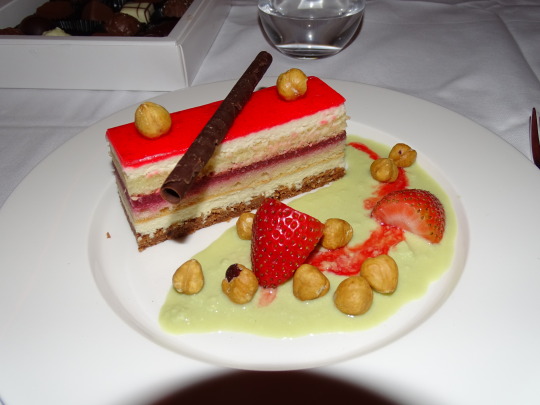



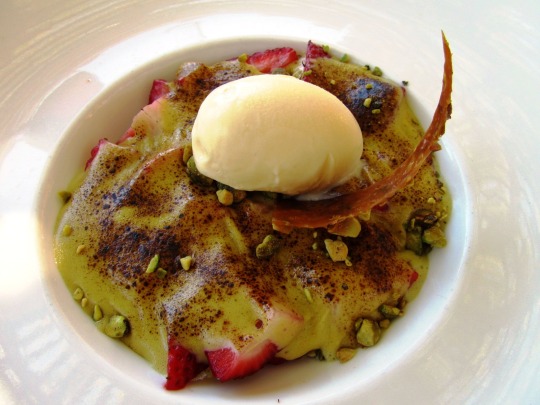

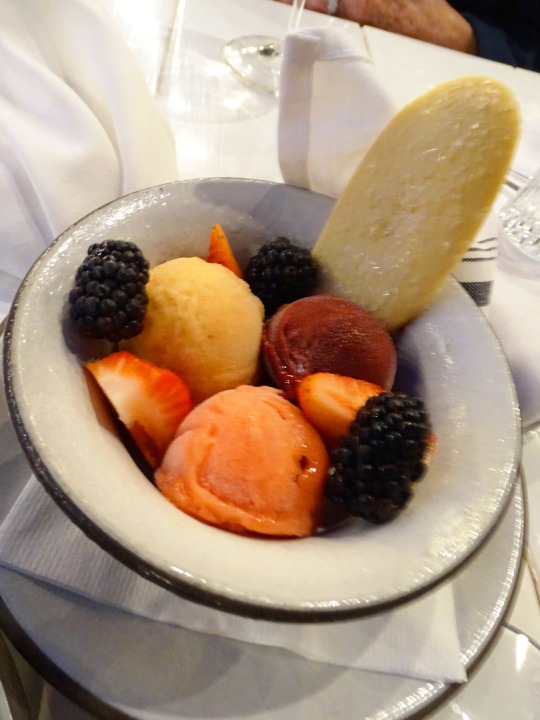








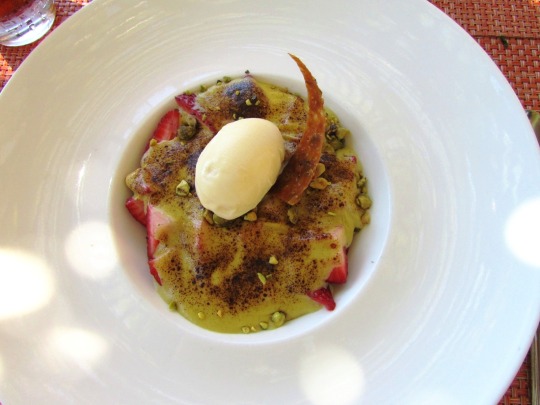
National California Strawberry Day
National California Strawberry Day falls on March 21 and you bet it’s the perfect holiday for nutrition lovers to bask in the fruity deliciousness of one of the world’s favorite fruits — strawberries! A whole day dedicated to strawberries? Why not? Not only does this yummy heart-shaped fruit warm countless hearts and delight bellies, but it’s also packed with goodness benefiting our heart, skin, brain, and much more. National California Strawberry Day was birthed in 1983 by the California Strawberry Advisory Board (now California Strawberry Commission) in celebration of strawberries, which can be enjoyed in a variety of recipes.
History of National California Strawberry Day
We all know strawberries rank among the world’s preferred fruits right now but did you know the existence of strawberries can be traced back centuries? According to popular belief, there are traces of strawberry plants in ancient Rome in 234 B.C., their use then was medicinal — they were used to treat depression, fever, kidney stones, and sore throats. By the 14th century B.C., the tiny rare fruit was cultivated in France. In America, the Europeans first discovered strawberries in 1588. However, the variants of strawberries enjoyed today differ from the earlier ones. In 1712, native strawberries landed in France from Chile they were crossed with European strawberries, and the result was the delicious, large berries enjoyed today.
The small bright, juicy, red strawberry, scientific name — Fragaria ananassa, rumored to be berries just like blackberries and raspberries aren’t really in the botanical sense of the word as they are derived from a single flower with more than one ovary, as compared to true berries from one flower and an ovary with several seeds. Examples of true berries are blueberries, gooseberries, cranberries, grapes, tomatoes, bananas, and peppers.
Strawberries are reputed to deliver a world of goodness: Wade off cancer, boost immunity, boost eye, and brain health, and reduce the risk of cardiovascular disease and stroke, among numerous benefits are loaded with vitamins, fiber, and antioxidants. Plus, strawberries seat comfortably as a low-calorie food too which helps with weight loss. Strawberries are also a highlight as they are dubbed as one of spring’s first fruits.
National California Strawberry Day timeline
234 B.C. Strawberries are First Found in Rome
The strawberry plant is first found in ancient Rome but is used for medicinal purposes.
1588 Europeans First Discover Strawberries
In America, the Fragaria virginiana, a species of strawberry native to North America, is found.
1712 Much Loved Strawberry Hybrid
Owing to a French excursion to Chile, the widely grown garden strawberry is born.
19th Century Strawberry Love Widespread
Fresh strawberries become a luxury, being served with cream, and champagne, among other delicacies.
National California Strawberry Day FAQs
How old is the oldest strawberry?
The royal sovereign dates back to 1892 and is one of the oldest varieties of strawberries that still delights households to date.
What is the sweetest variant of strawberry?
The Alpine Strawberry, also known as the wild strawberry, is small, and super sweet with a distinct flavor; it is easy to cultivate too. Such a delight.
What’s a fun fact about strawberries?
Strawberries belong to the rose family. It’s little wonder they smell just as nice too.
National California Strawberry Day Activities
Learn a new recipe
Enjoy a strawberry treat
Pick your strawberry
Strawberries come in about 600 varieties and can be enjoyed in plenty of ways; you could try the easy strawberry milkshake, perfect for any time of the day. All you need is frozen strawberries, milk, strawberry ice cream, whipped cream, and of course, strawberries.
There are lots and lots of options out there; strawberry sweets, strawberry ice cream, strawberry cakes, chocolate-covered strawberries, and strawberry shortbread cookies. Let your heart guide you!
The sunny weather brings the perfect opportunity to be outdoors picking your summer fruits — strawberries. Quick tip, mornings are best to pick and don’t forget to give yourself a treat once done.
5 Awesome Facts About Strawberries
The first fruits to ripen in spring
Strawberries are a terrific aphrodisiac
Strawberries were a symbol of love
Strawberries stand out
California is a major producer
Strawberries and honeyberries are known as the first fruits to ripen with the welcome of spring.
Just like chocolate, strawberries are known to boost mood, increase libido, and heighten pleasure.
In ancient Rome, strawberries were regarded as the symbol of Venus, the goddess of love.
Strawberries are the only fruit with seeds on the outside and that disqualifies them as berries.
California produces more than 80% of strawberries consumed in North America.
Why We Love National California Strawberry Day
Strawberries are super delicious
It’s the perfect healthy snack
Strawberries are symbolic
This nature’s delight is yummy and can be eaten in a variety of ways. Indulge in smoothies, puddings, ice cream, cake, breakfast fruits, desserts, or after-dinner snacks, depending on your preference.
Strawberries are low in calories so we don’t have to worry about packing extra pounds while enjoying the treat that provides tons of nutritional benefits. We love this!
The delicious treat has long been associated with purity, love, fertility, and rebirth. Go ahead, gift your loved one some strawberries today!
Source
#Trio of Sorbet#Strawberry Shortbread#strawberries with panna cotta#Sweden#dessert#restaurant#Brix Restaurant & Gardens#Berries&Cream#original photography#vacation#fruit#USA#Canada#travel#21 March#NationalCaliforniaStrawberryDay#whipped cream#national day#ice cream#Yountville#Napa Valley#one of my favorite restaurants#chocolate cake a la mode
4 notes
·
View notes
Text
♡ My 2023 retrospective: egl version ♡ PART 2/9
During the month of February, I also bought these shoes from a normie shop to use both in lolita and in normie outfits. You'll see them again later. I think they look good in lolita coords, especially with velveteen. I also got these bracelet and ring from Etsy.




A random building from the place where I live. I think it's pretty.
But the main event of February was the Divina Commedia tea party in Rome. It was my first international lolita tea party and I was very nervous. I had been planning my coord for one year, because it was the year I got back into lolita after a long hiatus and I had to gather all the right pieces.

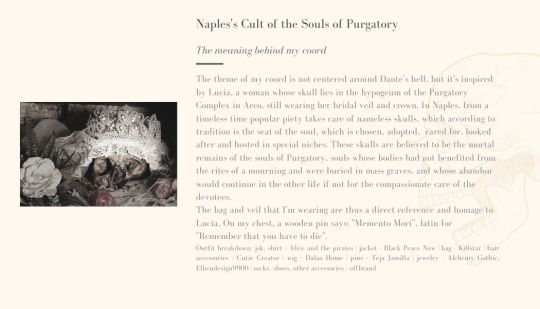
The theme of the event was Dante's Divina Commedia with its heaven, hell and purgatory. My coord was inspired by Naples's cult of the souls of purgatory. I even prepared a QR code for people to scan and read this little thing I wrote about it, but only one person actually scanned it.


I went with my friends Ilaria and @saturnia-pyri, but I look bad in every photo. If I could go back in time I wouldn't wear that wig, but I would probably have the same awkward face and poses. I'm so glad I got the chance to see my friends in that occasion, though.
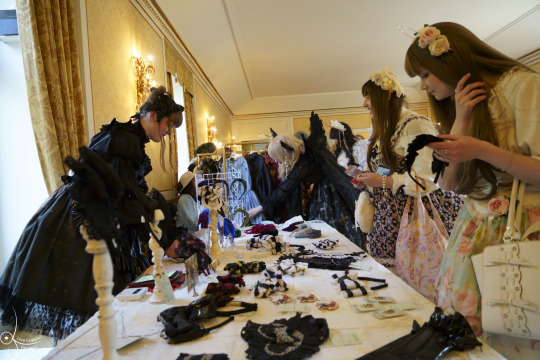

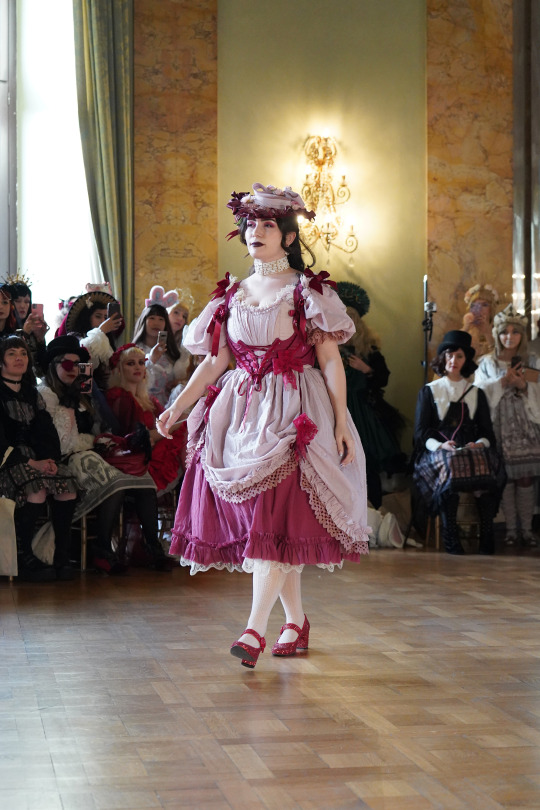

All in all it was a really beautiful event, it made me fall in love with this fashion even more. The clothes in the fashion show were gorgeous too. Seeing so many lolitas in one room is amazing, I loved how everyone was dressed, even the ones that were wearing other substyles that I don't usually like.



Me and my other friends also went to this cute café in Rome and we even got some macarons at the train station!
When I got back home from this wonderful trip, I was motivated to try something different from what I would normally wear.


This is an example of that. Which makes me realize that I did, in fact, wear this ETC jsk in one lolita coord: this one. It's a bit too much old school leaning for my taste, but it's still okay. Coord rundown: Jsk: Tea Cup Print Sleeveless OP by Emily Temple Cute Blouse: Baby the stars shine bright Bolero: Bodyline Socks: Angelic Pretty Everything else: Off-brand

March

In March I got these two things off lace market: the first one is this lovely pink AP blouse that I haven't worn yet (it was already too hot for long sleeves at the time); and the other one is this AP sailor cutsew that I did wear a couple of times, but not in a lolita coord.
March was also the month of our first meet of the year. We had a lovely picnic and visited our local botanical garden.
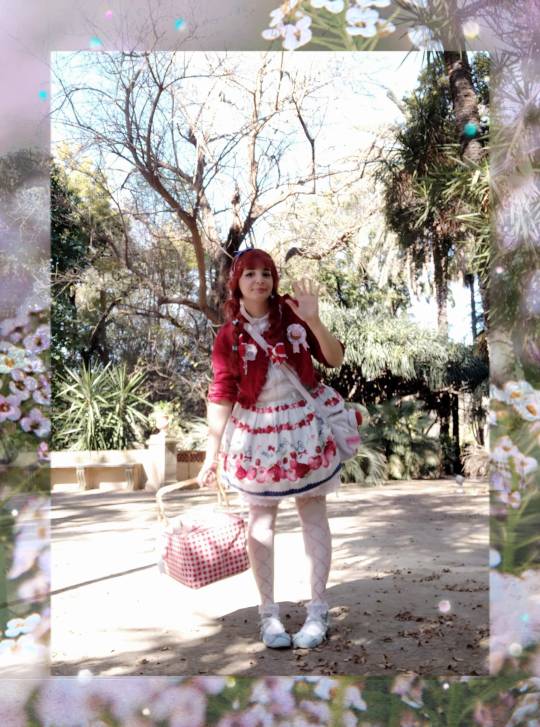


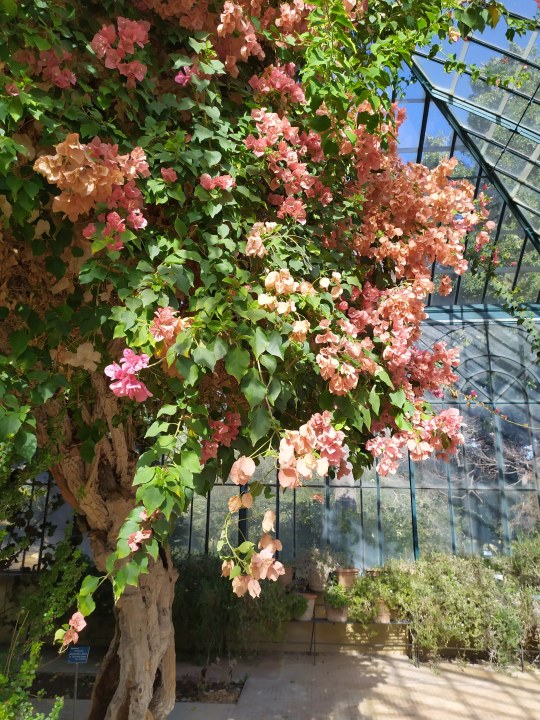
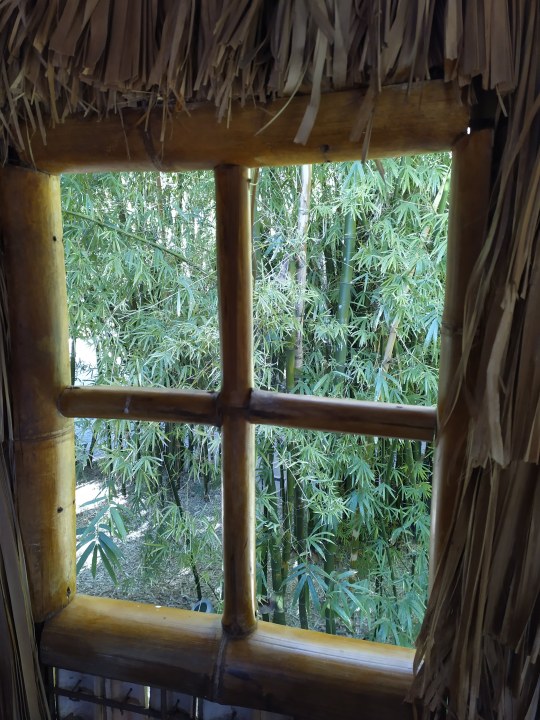

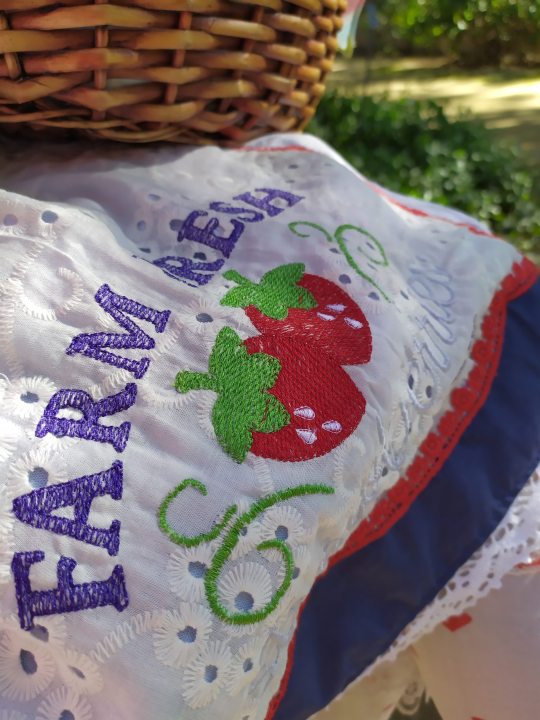
[END OF PART 2/9]
#egl#2023#summer tales#angelic pretty#tomoyo's atelier#vitae essentia#mine#diary#emily temple cute#baby the stars shine bright#alice and the pirates#killstar#alchemy gothic#black peace now#fidel david#bodyline#roji roji
3 notes
·
View notes
Text
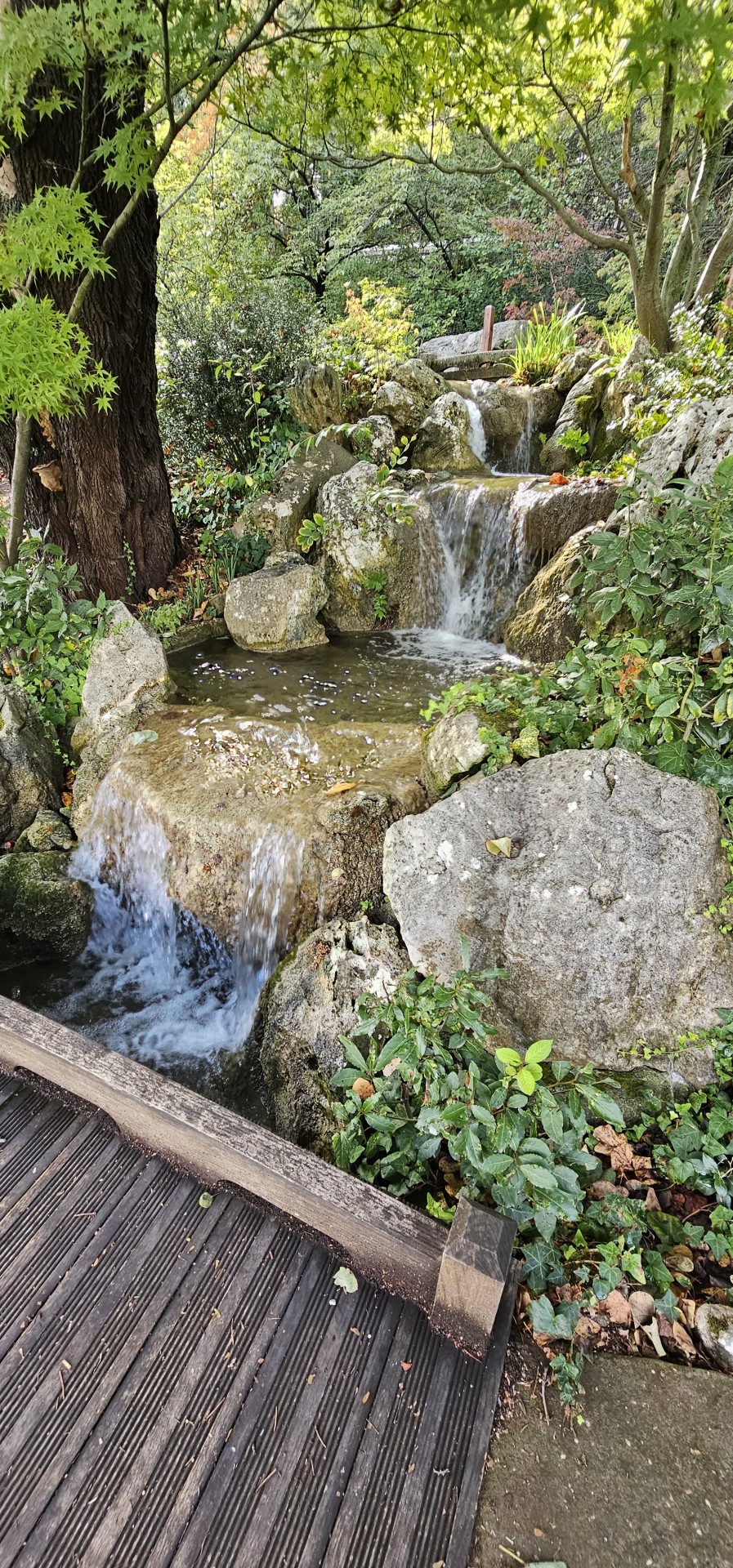
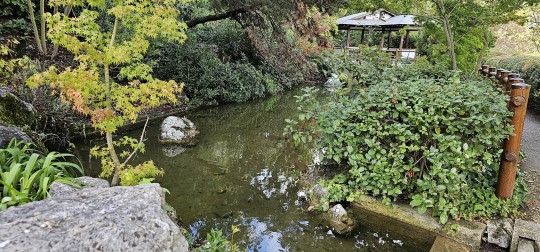


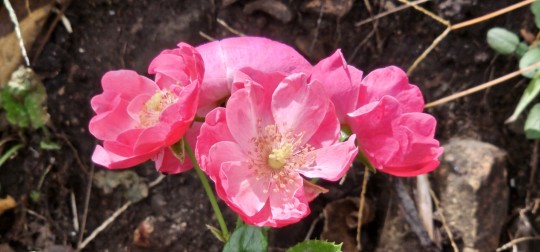
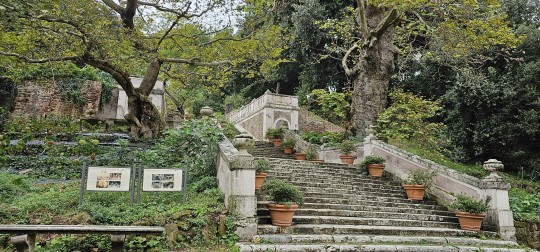


I'm making a side blog for all my Rome photos soon but right now I am sitting in the Botanical Gardens and I am so at peace and refreshed that I needed to share this with you all Right Now
5 notes
·
View notes
Text
Milan, Italy

Trams in Milan
The Milan tramway network is part of the public transport network of Milan, Italy, operated by Azienda Trasporti Milanesi. In operation since 1881, the network is currently 180.3 km long, making it one of the biggest in the world. It has the unusual track gauge of 1,445 mm, and comprises 17 urban lines.
Track length (double): 40.3 km (25.0 mi)
Trams in Milan - Wikipedia
Milan (Milano in Italian) is located in the province of Milano, west of the Lombardy region. Together with Rome, Florence, Venice and Naples, it is one of the five most visited cities in Italy. Milan is the hub of Italian culture, music, media, sports and fashion. it also has a wealth of interesting museums and things to see and do.

Duomo Cathedral Square, Milan, Metropolitan City of Milan, Italy
Art and Culture: Milan's Rich Heritage
Milan boasts many artistic and cultural landmarks. The magnificent Milan Cathedral, or Duomo, is a Gothic masterpiece that dominates the city's skyline. It is open daily 8.00 am - 7.00 pm. Last ticket: at 6.00 pm. Last admission: at 6.10 pm
A visit to Leonardo da Vinci's "The Last Supper" at the Convent of Santa Maria delle Grazie is a must for art enthusiasts

Fashion and Shopping: The Style Capital
Milan's reputation as a global fashion capital is well-deserved. The Quadrilatero della Moda, or the Fashion Quadrangle, is a district filled with high-end boutiques, luxury stores, and designer boutiques. Just stroll through this stylish area in the heart of Milan, bordered by Via Manzoni, Via della Spiga, Corso Venezia and Via Montenapoleone, known worldwide as the Fashion District.
These are the streets that make up Milan’s district devoted to luxury shopping and are known throughout the world.

Sforza Castle
Sforza Castle
The Castello Sforzesco (Italian for "Sforza's Castle") is a medieval fortification which was built in the 15th century by Francesco Sforza, Duke of Milan.
The Castle houses several museums:
The Museum of Ancient Art: The highlights of the museum include the Rondanini Pietà, the last and unfinished work by Michelangelo.
The Pinacoteca del Castello Sforzesco: This art collection is made up of over 1.500 works of art.
The Museum of Musical Instruments: This museum contains curious instruments from all over the world.
The Egyptian Museum: The Egyptian Museum houses several objects from Egypt, including statues and mummies.
The Archaeological Museum of Milan: This museum contains objects and items from the main cultures that lived in Lombardy.
The Applied Arts Collection
The Antique Furniture and Wooden Sculpture Museum

Milan's Parks and Gardens
Escape the urban hustle and bustle by visiting Milan's serene parks and gardens. Parco Sempione, the English landscape park was established between 1890 and 1893. located right behind the Sforza Castle it offers a tranquil setting for a quiet and relaxing walk.
Do you want to look at Milan City from the park? Then go to Torre Branca and climb the stairs (or take the elevator) for a fantastic panoramic view.
For a more offbeat experience, explore the Orto Botanico di Brera. This botanical garden, established in 1774 and restored in 1998, belongs to Milan University. Enjoy a stroll around the flowerbeds and fountain and admission is free.
Whether you're a culture aficionado, a fashionista, or simply seeking a taste of Italian life, Milan will not disappoint.
Credit: Milan: Where Tradition Meets
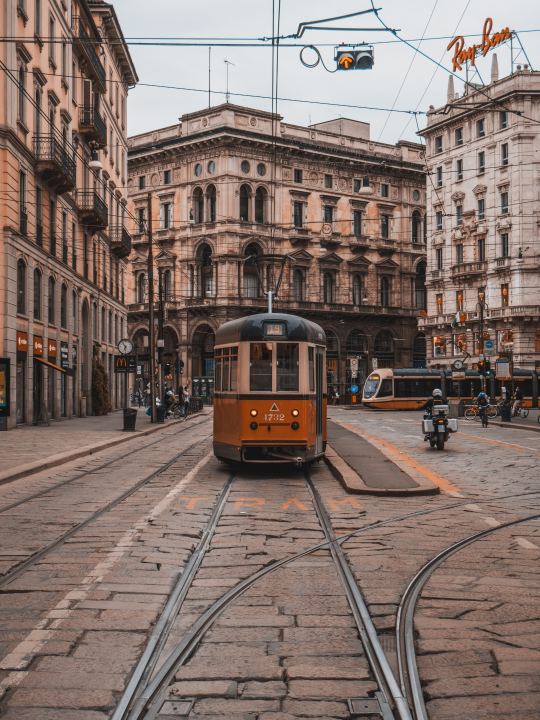
Milan, Italy
4K notes
·
View notes
Text
20-21 june
I awoke early again, rising as silently as I could while my roommates still slept on. The American staying here, Faith, is not so cautious—she tends to move about more recklessly, letting her locker door slam shut as she flings Midwest-blonde hair over her shoulder. My exit style is more of a creep; I slipped down the hall into a mild, overcast day and made my way back down the street to the same bakery I visited the day before. I bought my pain au chocolat and skirted the edge of the inner city, crossing the canal, until I had passed through an office district and arrived in the botanic gardens. There was a pair of grey geese paddling about in the leafy pond, and a few common turtles floating with their faces poking above the water.
Brussels has a thriving economy of pretentious coffee shops, and after purchasing my ice latte (presented creatively in a can rather than a cup), I walked on through Brussels Park, whose broad avenues were lined with all kinds of neoclassical statues. I saw two small brown rats scurrying about in the children’s playground and a few more waterbirds staking their claim to the parkland while most of the neighbourhood was still at rest. Over the line of the trees I saw the blue and gold-gilded dome of the Palais de Justice and the walls of the Royal Palace—I had come back around to the same old and grand part of Brussels had visited the day before. So it was a familiar journey as I made once more for the Grand Place marked on the horizon by the city hall spire.
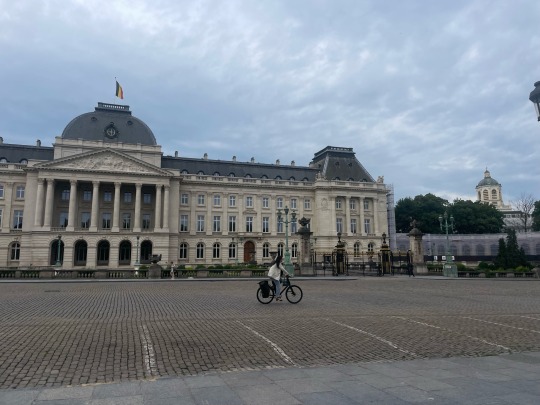
I was there on time to enter the Musée de la Ville de Bruxelles as it opened at ten o’clock. The collection includes the building that houses it, opposite the Hotel de Ville in the Grand Place. This black gothic creature stands out from the white and gold things that line the rest of the square—the Maison du Roi in its current form is little more than a century old, but the house that stood there before belonged to Charles V of Spain, and so it has its French name. But the Dutch language knows it as Broodhuis, because there was once a bread market in the square.
The museum is one of the most interesting collections I have been to because it is as much about the city of Brussels in the late 19th century as it is about the Brussels of antiquity. The first floor contains statues and altarpieces and pieces of façade from across the city which were replaced with replicas as city administrators of the 19th century sought to restore and preserve the old Brussels that had long been crumbling. Even the weather vane from the top of the town hall’s spire that shows the patron Saint Michael was eventually taken down and replaced with a copy, while his original form rests in the city museum. Climbing past the stained glass windows that showed the crests of noble families, I went through rooms of paintings that showed the city landscape and its people over the centuries—the same statues I had seen in the park an hour ago peered back at me from canvas, and I saw the square outside as it had been before, when tourists taking photos were traders selling dogs and racing pigeons.
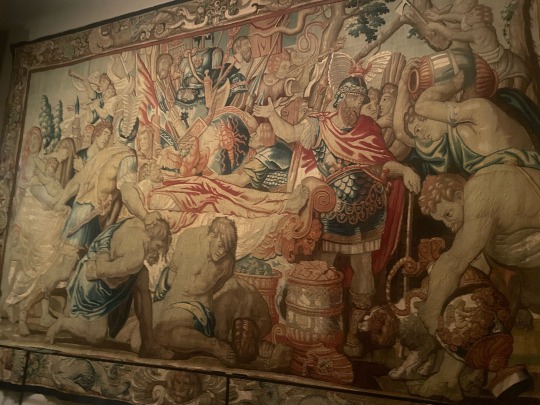
There was also a large collection of Belgian china and a dark room hung with tapestries not unlike the ones I had seen across the road—these are rotated regularly to keep them safe from the light. The only permanent fixture was the huge cartoon on the wall, which is one of the few surviving examples of those works used as guides for the production of the tapestries themselves. It showed the martyrdom of Saint Paul in the style of Ruebens, pale and stuck with the pinholes that showed it must have been copied in thread at least once.
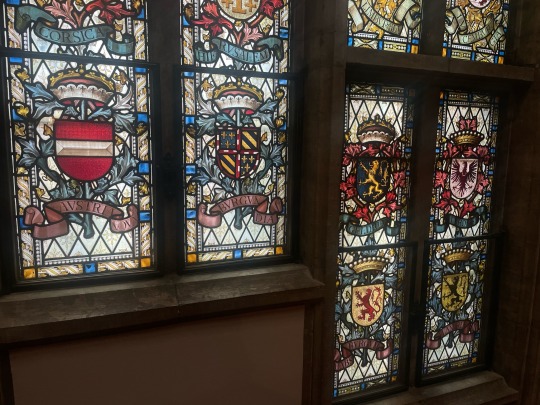
I had a midday train ticket, so I hurried up the street to Bruxelles Centrale, stopping along the way to buy a small book on the history of ancient Rome in case I was bored and needed to preserve my phone battery. My train was to Bruges and took about an hour, so I ate my supermarket sandwich and snacks on the way, watching the endless fields of horses and cows blur into green as we journeyed west. Bruges is unassuming from the view offered of it from the station square, but the moment one crosses the highway and enters the winding alleys it is clear why it has captured so much attention. Unlike Brussels its streets have not been invaded by the horrors of cheap post-war architecture, though they are no less a victim to the souvenir shops and chains of Belgian chocolate stores, so numerous on the main shopping street they became indecipherable from one another.
On my way into the heart of town I passed over my first canals with the flower box bridges—overlooking the water I saw a mother and father swan watching over their fluffy grey cygnets curled up on the bank for a nap. This peaceful scene was quickly eclipsed by the tourist throng as I turned onto one of the main streets and passed the largest church, taking a peek inside but deciding it was still too early in the day to pay to see ten more paintings of the crucifixion (I was feeling stronger by mid-afternoon). Instead I weaved on through the crowd to the main square, which was absolutely heaving with all kinds of family groups taking their photos and eating their waffles.
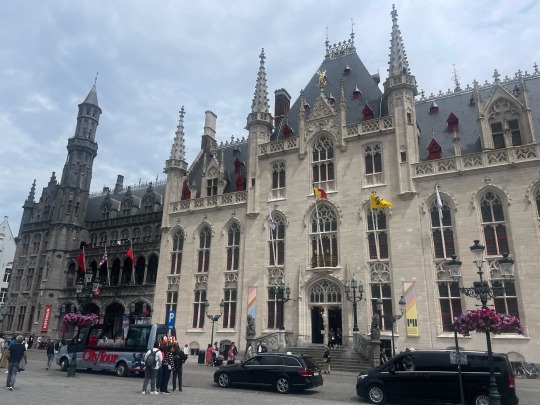
The highlight of the square is, of course, the bell tower, rising above the entire town skyline. Every fifteen minutes it would ring some melodic tune, like a wind chime. But I was more intrigued by its alleged 362 steps, and was surprised again to find that almost nobody from the crowd of hundreds was curious about the inside of the building they stood milling around—I bought a Bruges museum pass for the day and began the climb. The first spiral of the belfry’s steps is deceiving, broad and flat and made from modern, level stone. Once I had passed the first chamber (the room where the city administration stored their precious documents in ancient times to protect them from fire), the stairs narrowed to that classic worn-down configuration and it became necessary to clutch at the thick winding rope around the centre for balance.
I sped up as fast as I could even though I was sweating quite a bit, only pausing when someone was coming the other way and the width of the passage became problematic. There was a certain satisfaction to leaving behind all those shallow travellers and their commercial interests down below; also, I was raised in such a way that there is no question of if when it comes to towers, belfries and domes. One must at least pay their respects to whatever poor person had the job of climbing every day to ring the giant bells manually in times past. I emerged victorious at the top of the final staircase, which was more of a ladder than anything else, and saw the beautiful panoramic view of Bruges, well worth the climb. The town from above was a uniform sprawl of two-storey houses broken up only by the occasional church spire and patches of green, larger from above than the quaint streets implied below. While I was up there the bells chimed and everybody got a fright. The stairs seemed impossibly steeper on the way down. I was somewhat more cautious on the descent.
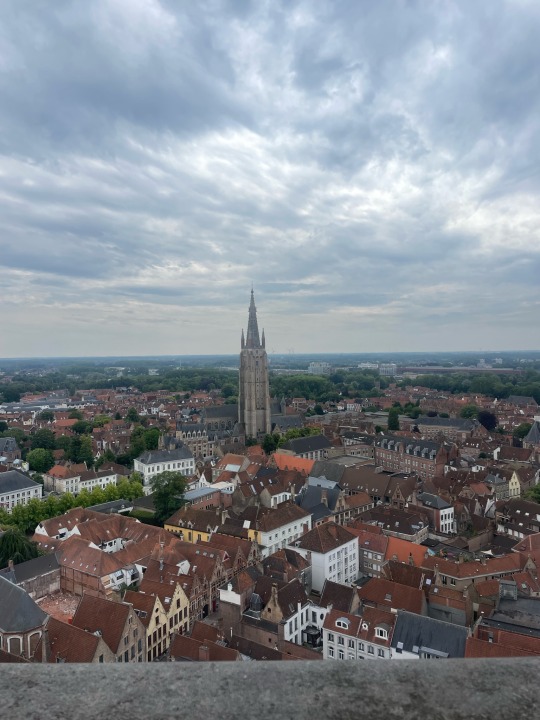
Having proved myself, I decided it was time to join in with everyone else, so I went to a highly recommended waffle shop and bought the plain Liège waffle, since I still have my principles. Most are drawn in by the array of sweet sauce and candy toppings offered (though to be fair, this shop was a little more restrained than the tacky places populating Brussels), but I understand the only correct way to eat the Liège waffle (which is different to the Brussels waffle), is in its classic form. It came hot from the press, oval-shaped with the layer of caramelised sugar that makes the Liège waffle—proud of this too, I took it back to the main square to show off. It was genuinely very good, better than the stuff in Brussels would be, I think, and after speed-running that belfry climb it was a needed restorative. I had a museum pass that I had to use on at least one more attraction to get my money’s worth.
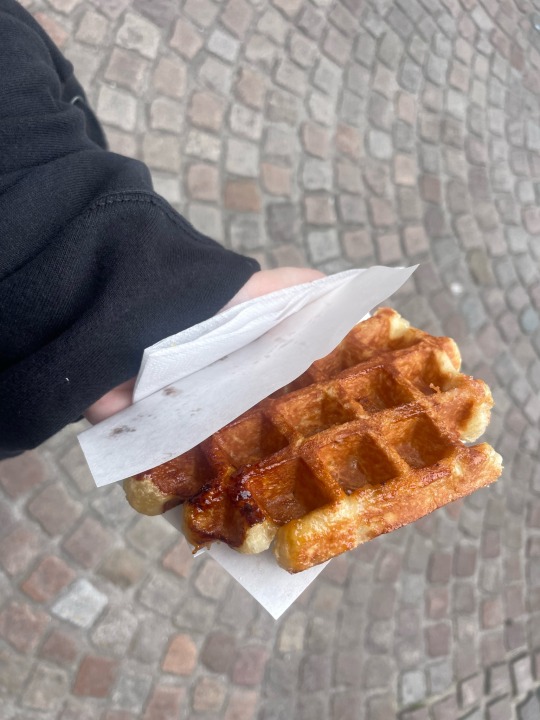
Bruges hosts the works of great Flemish masters in the Groeningemuseum, tucked away down a path that winds through a small garden off the main canal. I came in just in time to eavesdrop a little on one of the gallery tour guides and his collection of elderly listeners—I was just about the only person younger than sixty-five in the whole building. The most significant work in the museum’s care is Jheronimus Bosch’s Last Judgement, which is absolutely wonderful, and may even beat the Brueghel I saw the day before. The three-panel picture depicts a very strange reckoning for the human race, in which the land is covered with the strangest little creatures, not so much monstrous as they are disconcerting. A devil tortures a man over a giant butterknife, another sits on the back of a kind of rabbit thing carrying his cage of humans enslaved, another—a harpy—perches with a person half sticking of her obscenely large maw as she chews them up. But the picture is so unusual and charming that it fails to disgust the modern eye. You have more of a feeling like you’d want to put one of these little things in your pocket and carry it about like a pet than a desire to run and repent. The museum seems to understand this; they sell very nice metal charms and pins of the most memorable creatures.
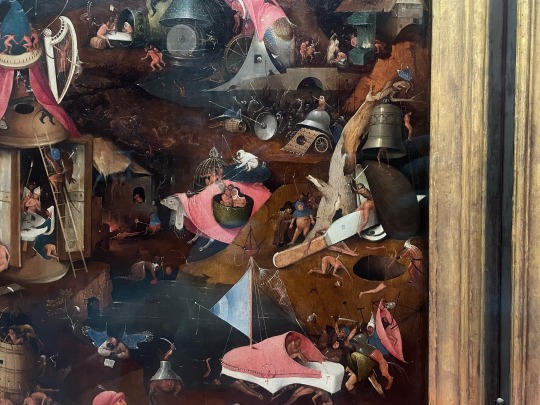
My phone was threatening to accept death by this point, so I put it away and went for a walk towards the Begijnhof, the old religious women’s refuge which still acts as a community today. Before its gated entrance was a canal bank with a whole colony of waterbirds – a great throng of swans and ducks, so numerous the ground was littered white with downy feathers. Most of them were sleeping with their necks all twisted up and their beaks tucked away, protected from human advances by a handy fence. I continued through these green spaces along the banks of the canals, skirting the outside of town until I dropped back onto the main street (the quiet, local end) and bought some frites from the very kind people behind the counter. This, obviously, was the other necessity staying in Belgium, now I had crossed waffles off the list. They were so good, though I do think the Belgians go a little overboard with their mayonnaise portions. I like mayonnaise but not that much.
I could have stayed even longer, but my phone was on its last legs, and I was beginning to feel the day’s toll. Luckily I’d picked up a map at the info centre earlier and had been using that for navigation for the past hour or two since the phone map became untenable, and Belgium is very good with its street signs. When I was walking back over that same small bridge I saw the swan family from earlier, taking to the waters now. I watched them go—two sleek and white, two downy and grey—until they disappeared under the bridge and were gone from view. Bone tired, I slumped on the soonest train back to Brussels in a corner by myself. My phone, at least, made it back alive, and I went to bed after some takeaway dinner with great anticipation.
I was up bright and early for yet another train, this time northbound from Bruxelles-Centrale for Antwerp, where I would be meeting two of my close friends Connie and Maddy for the day. They have been staying in Amsterdam and seem to hate it with a passion, so the day trip was in their interest even though they had a much longer train journey than me. As I came up the stairs of Antwerpen Centraal I saw them waiting for me at the top, framed by the station’s ornate walls and domes from the turn of the 19th century—the spiralling stone and brass and wrought iron over glass that barely survived the war. We hugged and headed outside to a city still waking; my friends, who aren’t so used to Europe’s quirks, said they thought all the locals looked shellshocked as though we were in Soviet Russia. Having only been to Paris and Amsterdam so far, they are yet to appreciate the no man’s land of industrial European city streets before ten o’clock in the morning.
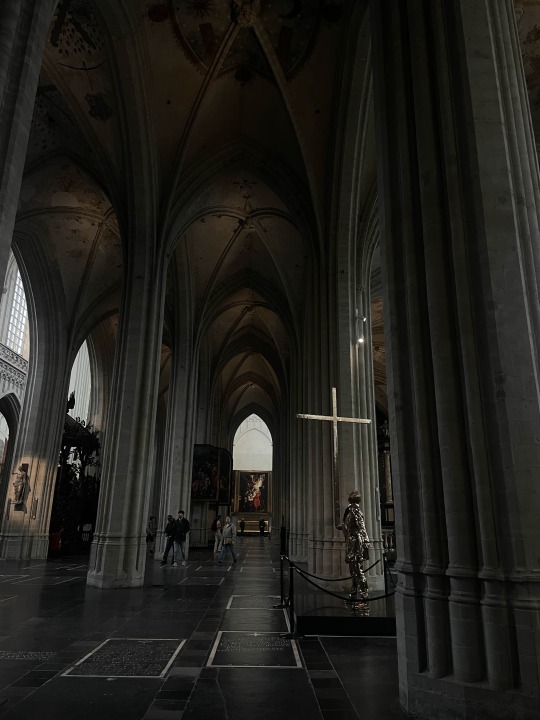
Since nothing was open yet, we stopped for coffee outside Antwerp’s cathedral, sheltered from the dreary day. The inside of the cathedral housed a few grand paintings by Ruebens and some beautiful chapels—we wandered around inside for a while and I enjoyed the commentary of Connie, who as an art history student always has something to say. The cathedral had that overwhelming Catholic air with its countless variations of Mother and Child; the right chapel had frames depicting Jesus carrying the cross while the left chapel, dedicated to Mary, showed the stages of her life from the Annunciation to the Resurrection. Connie and I agreed it was interesting to see a depiction where Mary was shown to age with time and grief rather than remain eternally young and beautiful. The cathedral of Antwerp is an ancient one, built between the 14th and 16th centuries upon earlier foundations. Fire, Protestants and French revolutionaries all took their turn at trying to destroy its walls over the many years, but none succeeded.

My friend Connie has an intense love of couture fashion, and apparently the clothes of Belgian designer Ann Demeulemeester can only be seen in store in Antwerp. Connie was desperate to try on a dream pair of laced boots, so after a little more than an hour of deliberation between sizes, we left with the heels of her new shoes clicking on the rain-soaked pavement. Maddy and I were a bit beside ourselves with hunger at this point—we ate in a Vietnamese restaurant around the corner while it continued to pour outside. Fortunately the Royal Arts Museum of Antwerp was almost only just across the road, so I dashed to cover while Connie and Maddy performed more of a creep under the shelter of Connie’s umbrella. The water pooled in the recesses of the worn tiled pavement and for once my tired canvas sneakers were not the least suitable choice of footwear between us.

The building of the Royal Arts museum is an old one with a huge painted entrance hall, and it feels like entering another world when you ascend to the first floor and find the modern masters artfully curated in stark white rooms. Climbing the stairs between galleries we ascended into darkness, into deep navy rooms of statuettes and quiet shadowy paintings, only to be thrown back into to piercing brightness. The arrangement of the gallery felt only more poignant as we at last reached the level containing the old masters, encircling a hall where more Ruebens were on display. In one corner of the room one of these Ruebens was frameless, turned up on its side while the museum’s conservation workers toiled peaceably at restoring the work in front of the public, removing its centuries-old varnish. In the other rooms were many of the same sort of paintings I’d become familiar with—Biblical allegories, portraits of families in black with their frilled collars, landscapes with fine houses and grazing livestock. I was most fond of Misbehaving, a Henriette Ronner-Knip, and the famous Madonna by Jean Fouquet. After laying out on the plush benches of the gallery for a while, we stepped back into the streets of the city; it was no longer raining.
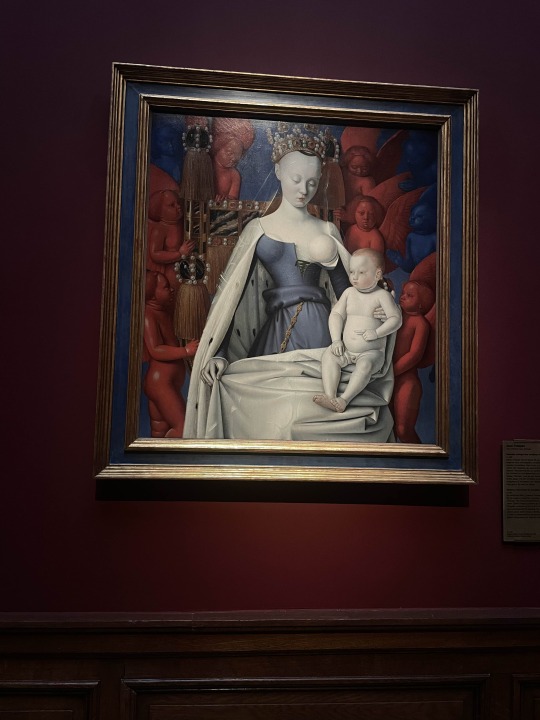
We went for Belgian waffles, I had mine with chocolate and strawberries (which is allowed in this case, because it was the Brussels waffle rather than the Liège one) and went to see the main square, enclosed as usual with the familiar old municipal buildings. At the end of the street down by the water we sat for a while in the information centre, housed in what remains of a medieval castle. Their Eurostar back to Amsterdam was in the evening, so we had just enough time to eat some pasta at a nice Italian restaurant just off the main square before beginning the walk back to the station. The first train to Brussels was on the platform opposite theirs, so we parted ways but kept in sight until my train arrived to block them from view. I will see them again in Florence, but for now our destinations are very different. In Brussels I packed my bag ahead of my departure and curled up in bed with some dessert—ahead of me was my two-day journey to Prague across the German countryside.
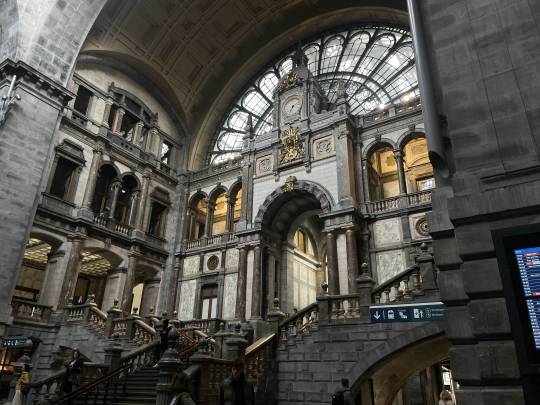
0 notes
Text
Meshell Ndegeocello Shares Love From James Baldwin Tribute Album & Plays Tiny Desk For Black Music Month

Meshell Ndegeocello shares "Love" from her forthcoming No More Water: The Gospel of James Baldwin and performs her second Tiny Desk Concert for their Black Music Month celebration. "Love" fetes vulnerability and connection in a shower of hi-hats, sweet melody, sacred choruses, and Meshell's funk-wielding bass. She performed the single along with "Travel," and "Thus Sayeth The Lord," from the album. "Virgo" is from her 2023 album The Omnichord Realbook and "Outside My Door" is from her 1993 debut album Plantation Lullabies. No More Water will be released on Baldwin's centennial August 2nd and Ndegeocello will headline the BRIC Celebrate Brooklyn Festival.
youtube
youtube
Tour Dates
July 5 – Love Supreme Festival – East Sussex, United Kingdom July 7 – Casa del Jazz – Rome, Italy July 8 – Bremen Theater – Copenhagen, Denmark July 10 – Marseille Jazz des Cinq Continents – Marseille, France July 12-14 – North Sea Jazz Festival “Artist In Residence” – Rotterdam, Netherlands July 16 – Jazz a Sete Festival – Sete, France July 19 – Festival Jazz en Ville – Vannes, France July 21 – Stuttgart Jazz Open Festival – Stuttgart, Germany July 23 – Jazz in Marciac – Marciac, France Aug. 2 – BRIC Celebrate Brooklyn – Brooklyn, NY Aug. 4 – Newport Jazz Festival – Newport, RI Aug. 7 – Denver Botanic Gardens – Denver, CO Aug. 8 – Ravinia Festival – Highland Park, IL Sept. 15 – New Mexico Jazz Festival – Santa Fe, NM Sept. 16 – MIM – Phoenix, AZ Sept. 20 – The Center for the Arts at the Armory – Somerville, MA Sept. 21 – Empire State Plaza Performing Arts Center – Albany, NY Sept. 22 – Wexner Center for the Arts – Columbus, OH Sept. 26 – Infinite Dream Festival – Iowa City, IA Sept. 28 – Wisconsin Union Theater – Madison, WI Sept. 29 – Door Community Auditorium – Fish Creek, WI Oct. 3 – World Café Live – Philadelphia, PA Oct. 5 – The Music Center at Strathmore – North Bethesda, MD Oct. 6 – New Jersey Performing Arts Center – Newark, NJ Oct. 31 – JazzOnze+ Festival Lausanne – Lausanne, Switzerland Nov. 1 – Enjoy Jazz-Alte Feuerwache – Mannheim, Germany Nov. 3-4 – Stadtgarten Konzertsaal – Cologne, Germany Nov. 6-7 – Musikbrauerei – Berlin, Germany Nov. 9 – Rockit Festival – Groningen, Netherlands Nov. 10 – Le Guess Who? Festival – Utrecht, Netherlands Nov. 11 – De Roma – Antwerp, Belgium Nov. 12-13 – New Morning – Paris, France Nov. 15 – Koko – London, United Kingdom Dec. 2-5 – Jazz Alley – Seattle, WA Nov. 7 – Walter Art Center – Minneapolis, MN
1 note
·
View note
Note
**I will keep updating this post, it’s pinned to my blog**
LIAM PAYNE MEMORIAL (Update)
Online
Virtual memorial | October 20 - 12pm EST
Meeting ID: 815 4938 9948
Passcode: 684974
Online Memorial | October 29 | Follow this blog for more info:
Digital Wall | Messages for Liam | this will stay up forever
Petition | Enact Legislation to Safeguard Artists' Mental Health in the Entertainment Industry
Europe
🇬🇧 🏠 Wolverhampton | October 18 - 6pm | The Halls, University of Wolverhampton
🇬🇧 Holmes Chapel | October 21 - Morning | Train Station
🇬🇧 London | October 20 - 2pm | Hyde Park meeting point at Peter Pan statue
🇬🇧 Liverpool | October 19 - 2pm | Docks on keel wharf bridge
🇬🇧 Glasgow | October 20 - 2pm | Sir Walter Scott Statue in George Square
🇬🇧 Manchester | October 20 - 6pm | Cathedral Gardens
🇬🇧 Birmingham | October 20 - 4pm | Chamberlain Square
🇬🇧 Belfast | October 20 - 4pm | Palm house at Botanic Gardens
🇬🇧 Edinburg | October 20 - 3pm | The Meadows
🇬🇧 Scotland | October 20 - 2pm | Beach front (across from Inoflate)
🇬🇧 Newcastle | October 20 - 2pm | Outside Church of St Thomas
🇬🇧 Bath | October 20 - 12pm | Bath Abbey
🇬🇧 Sheffield | October 20 - 3pm | Town Hall
🇮🇪 Dublin | October 19 /20 - 2pm | St Stephen’s Green
Link: https://t.co/SpzoWGMjX6
🇮🇪 Cork | October 20 - 4pm | Bishop Lucey Park
🇮🇪 Galway | October 20 - 4pm | Eyre Square |
Link: chat.whatsapp.com/FCjQMWN1B2U9iD…
🇫🇷 Paris | October 20 - 2pm | Jardins des Tuileries
🇫🇷 Toulouse | October 20 - 6pm | Jardin Royal
🇫🇷 Rennes | October 20 - 3:30pm | Parc du Thador
🇫🇷 Lyon | October 20 - 2pm | Place Antonin Poncet
🇫🇷 Montpellier | October 20 - 2pm | Jardin du Champ de Mars
🇫🇷 Lille | October 20 - 2pm | Parc de la Citadelle
🇫🇷 Bordeaux | October 20 - 2pm | Jardin public
🇫🇷 Nancy | October 20 - 2pm | Parc de la pépinière
🇫🇷 Marseille | October 20 - 2pm | En bas de Notre Dame de la Garde
🇫🇷 Strasbourg | October 20 - 2:30pm | Parc de l’Orangerie
🇫🇷 Rouen | October 20 - 2pm | Square Verdrel
🇫🇷 Nice | October 20 - 2:30pm | Jardin Albert 1er
🇫🇷 Dijon | October 20 - 2pm | Jardin de l’Arquebuse
🇩🇪 Munich | October 20 - 3pm | Olympiahalle
🇩🇪 Cologne | October 20 - 4pm | Cologne Cathedral
🇩🇪 Berlin | October 20 - 4pm | S Treptower Park (Ost)
🇩🇪 Frankfurt | October 20 - 3pm | Metzlerpark
🇩🇪 Düsseldorf | October 20 - 3pm | Rheinpark
🇩🇪 Hamburg | October 20 - 3pm | Amphitheater
🇩🇪 Dresden | October 20 - 2pm | Frauenkirche/Blaues Wunder
🇩🇪 Dortmund | October 20 - 2pm | Treffpunkt am Dortmunder Hauptbahnhof
🇩🇪 Hannover | October 20 - 5pm | Opernplatz
🇩🇪 Several cities around the country https://t.co/pJfzDfC4BL …
🇳🇴 Oslo | October 19 - 3pm | Utenfor Oslo Domkirk
🇫🇮 Helsinki | Olympiastadion (outside south entrance) | NO GATHERING
🇸🇪 Stockholm | October 19 - 6pm | Svartensgatan 8
🇩🇰 Odense | October 18 - 7:30pm | Odense Domkirke
🇳🇱 Utrecht | October 20 - 2pm | Central Station
🇳🇱 Utrecht | October 26 - 2pm | ?
🇧🇪 Brussels | October 19/20 - 2pm | Parc de Bruxelles
🇪🇸 Madrid | October 19 - 7pm | Parque Del Retiro
🇪🇸 Madrid | October 20 - 3pm | Plaza de Santa Ana
🇪🇸 Barcelona | October 20 - 4pm | Plaza Cataluña Al lado Primark
🇪🇸 Bilbao | October 20 - 4:30pm | Ayuntamiento
🇪🇸 Palma - Mallorca | October 19 - 6pm | Parc de la Mar
🇵🇹 Lisbon | October 27 - 6pm | Meo Arena, Oriente
🇵🇹 Oporto | October 20 - 3:30pm | Stadium of Dragão
🇮🇹 Milan | October 20 - 3pm | Piazza Duomo
🇮🇹 Rome | October 20 - 3pm | Villa Borghese
🇮🇹 Naples | October 27 - 5pm | Piazza Del Plebiscito
🇮🇹 Bologna | October 20 - 3pm | Piazza maggiore
🇮🇹 Bari | October 27 & November 3 - 5:30pm | Caserma Rossani
🇮🇹 Pisa | October 26 - 4pm | Giardino Scotto
🇮🇹 Udine | October 26 - 4pm | Piazza Primo Maggio
🇮🇹 Salerno | October 26 - 4pm | Piazza Della Liberta
🇮🇹 Catania | October 20 - 5pm | Villa Bellini
🇬🇷 Athens | November 2 - 12pm | OAKA stadium, "Eirini" metro station
🇬🇷 Thessaloniki | November 2 - 12pm | Pasha's Gardens
🇵🇱 Warsaw | October 20 - 1pm | 12 Kawalerii Street
🇩🇰 Skive | October 18 - 8pm | Skive Anlæg
🇭🇺 Budapest | October 20 - 5pm | Hero's Square
🇦🇹 Vienna | October 20 - 3pm | Ernst-Happel-Stadium
🇦🇹 Vienna | October 27 - 3pm | Ernst-Happel-Stadium
🇨🇭Zurich | October 19 - 2pm | Blatterwiese (next to Chinagarten)
🇨🇭Bern | October 20 - 2pm | Wankdorf Stadium
🇨🇿 Prague | October 20 - 4pm | Wenceslas Square
🇭🇺 Budapest | October 19 - 10am | Városliget
🇺🇦 Kiev | UK Embassy | NO GATHERING
South America, Oceania & Asia
South America:
🇧🇷 São Paulo | October 27 - 2pm | Parque Ibirapuera
🇧🇷 São Paulo Esalq | October 27 - 3pm | Piracicabara
🇧🇷 Rio de Janeiro | October 27 - 1pm | Quinta de Bao Vista
🇧🇷 Belo Horizonte | October 20 - 2pm | Pampulha
🇧🇷 Curitiba | October 27 - 3pm | Jardim Botânico
🇧🇷 Belém | October 19 - 9am | Praça Batista Campos
🇧🇷 Brasília | October 25 - 5:30pm | Biblioteca Nacional
🇵🇪 Piura | October 18 - 8pm | Plazuela Ignacio Merino
🇵🇪 Arequipa | October 20 - 3:30pm | Campo de Marte
🇵🇪 Lima | October 19 - 6pm | Parque al costado del Club Internacional
🇧🇴 La Paz | October 18 - 6pm | Puerta de la embajada britanica, Av. Arce
🇧🇴 La Paz | October 19 - 4pm | Teatro al aire libre
🇧🇴 Santa Cruz | October 19 - 4pm | Parque los Mangales (Av. Beni, 4to anillo)
🇧🇴 Cochabamba | October 20 - 5pm | Parque del Arquitecto
🇧🇴 Sucre | October 19 - 5pm | Plaza 25 de Mayo
🇧🇴 Oruro | October 19 - 5pm | Parque ecológico
🇺🇾 Montevideo | October 20 - 2:30pm | Rambla Kibon
🇨🇱 Santiago | October 19 - 4pm | Av. El Bosque Nte. 125, Las Condes
🇵🇾 Asuncion | October 19 - 5pm | Costanera
🇸🇻 Salvador | October 19 - 3pm | Parque del Bicentenario
🇲🇽 Monterrey | October 20 - 4pm | Macroplaza
🇲🇽 Mexicali | October 20 - 12pm | Vicerrectoria UABC Campus Mexicali
🇲🇽 Juárez | October 19 - 3:30pm | Parque Central Pointe
🇲🇽 Guadalajara | October 19 - 2:30pm | Rotonda de los Jalisciences illustres
🇬🇹 Guatemala City | October 19 - 4pm | Plaza El Obelisco
Oceania:
🇳🇿 Auckland | October 20 - 2pm | Freyberg Square
🇳🇿 Wellington | October 20 - 5pm | Katherine Mansfield Memorial Park
🇦🇺 Sydney | October 20 - 11am | Hyde Park (Memorial fountain)
🇦🇺 Brisbane | October 20 - 3pm | ***Post Office Square Park
***RSVP : [email protected]
🇦🇺 Brisbane | October 20 - 2:30pm | River Quay Green
🇦🇺 Melbourne | October 20 - 11am | Flagstaff Gardens
🇦🇺 Adelaide | October 20 | Elder Park - River Torrens
Asia:
🇮🇳 Mumbai | October 20 - 5pm | Marine Lines, Opposite Pizza by the Bay
🇮🇳 Bandra | October 23 - 6pm | Mont Mary Church
🇮🇳 Delhi | October 19/20 - 12pm | Lodhi Gardens
🇮🇳 Hyderabad | October 20 - 6pm | Sanjeevaiah Park
🇮🇳 Kolkata | October 20 - 1pm | Maidan (Opposite Victoria Memorial
🇵🇭 Manila | October 19 - 10am | Sun Garden - 5th Floor
🇯🇵 Tokyo | October 20 - 2pm | Yoyogi Park - central field
North America & Canada
🇨🇦 Canada:
▪️Toronto | October 20th - 6pm | High Park
▪️Montreal | October 20 - 1pm | 4601 R. Sherbrooke E (Close by the Olympic Stadium)
▪️Vancouver | October 20 - time tbd | Art Gallery (FB group: https://m.facebook.com/groups/1081994593620682/)
🇺🇸 US:
▪️Newark - Delaware | October 19 - 4pm | Glasgow Park
▪️NYC | October 19 - picnic* at 11am and another event at 6pm | Washington Square Park
*Picnic RSVP : https://partiful.com/e/2WoJi0Onf8jWijlyFU8E
▪️Chicago | October 19 - 2pm | Gather at Grandmother’s Garden outside of Lincoln Park Zoo
▪️Los Angeles | October 19 - 4:30pm | La Cienaga** Park in Beverly Hills
**RSVP : https://partiful.com/e/P5qPcaZkgLizNYhzP0mm
▪️Bellingham - WA | October 19 - 5pm | Maritime Heratige
▪️Glendale - AZ | October 18 - 6pm | Glendale Heroes Reginal Park
▪️Louisville - KY | October 19 - 5pm | Cherokee Park
▪️San Francisco | October 18 - 6pm | Civic Center Plaza
▪️Long Beach - CA | October 18 - 6:30pm | Bixby Park
▪️Sacramento - CA | October 18 - 6:30pm | Memorial Auditorium
▪️Boston - MA | October 19 - 2pm | Boston Common
▪️Lewisville - TX | October 21 - 11am | On The Border
▪️Pittsburgh - PA | October 20 - 5pm | Schenley Park (Flagstaff Hill Pavilion)
▪️Fresno - CA | October 18 - 6:30pm | Save Mart Center
▪️La Jolla - CA | October 18 - 7pm | 12600 N Torrey Pines Rd
▪️Houston | October 20 - 5pm (picnic***) | Herman Park
***RSVP pls look at the IG @/1dlover904
▪️Philadelphia | October 20 - 1pm | The Lakes at FDR Park
▪️Atlanta - GA | October 19 - 2pm | Piedmont Park
▪️Minneapolis | October 20 - 5:30pm | The Common Park
▪️Orlando - FL | October 21 - 6:30pm | Lake Eola Park
▪️Seattle - WA | October 19 - 12pm | International fountain (Seattle Center)
▪️Cleveland - OH | October 20 - 6pm | Edgewater Park RVSP: https://partiful.com/e/TlvRTKsIVADl2AND1efp
Hi Sabine if you could please spread this, this account lists all the memorials planned for Liam across the world and regularly updates them, for those who wish and are able to attend https://x.com/HS_News_/status/1847077799942934740
Sending lots of love ❤️❤️❤️
LIAM PAYNE MEMORIAL
Europe:
🇬🇧 London | October 20 - 2pm | Hyde Park
🇬🇧Liverpool | October 19 - 2pm | Docks on keel wharf bridge
🇬🇧 Glasgow | October 20 - 2pm | Sir Walter Scott Statue in George Square
🇬🇧 Manchester | October 20 - 6pm | Cathedral Gardens
🇬🇧 Birmingham | October 20 - 4pm | Chamberlain Square
🇧🇪 Brussels | October 19/20 - 2pm | Parc de Bruxelles
🇫🇷 Paris | October 20 - 2pm | Jardins des Tuileries
🇩🇪 Munich | October 20 - 3pm | Olympiahalle
🇪🇸 Madrid | October 20 - 3pm | Plaza de Santa Ana
🇸🇪 Stockholm | October 19 - 6pm | Svartensgatan 8
🇵🇹 Lisbon | October 27 - 6pm | Meo Arena, Oriente
🇮🇹 Milan | October 20 - 3pm | Piazza Duomo
🇺🇸 US:
Newark - Delaware | October 19 - 4pm | Glasgow Park
NYC | October 19 - picnic* at 11am and another event at 6pm | Washington Square Park
*Picnic RSVP : https://partiful.com/e/2WoJi0Onf8jWijlyFU8E
Boston | October 19 - 2pm | Boston Common
Chicago | October 19 - 2pm | Gather at Grandmother’s Garden outside of Lincoln Park Zoo
Los Angeles | October 19 - 4:30pm | La Cienaga** Park in Beverly Hills
**RSVP : https://partiful.com/e/P5qPcaZkgLizNYhzP0mm
South-America:
🇧🇷 São Paulo | October 27 - 2pm | Parque Ibirapuera
Oceania:
🇳🇿 Auckland | October 20 - 2pm | Freyberg Square
🇦🇺 Sydney | October 20 - 11am | Hyde Park (Memorial fountain)
Asia:
🇮🇳 Mumbai | October 20 - 5pm | Marine Lines, Opposite Pizza by the Bay
———————
EDIT: added Boston
#rip liam payne#liam payne#memorial#liam payne memorials#make sure to check this post on my blog#I will keep updating it
546 notes
·
View notes
Text
Wk 16, 25th of May, 2024 Research Herbals, how plants have been seen

Lilium Lily, Early printed herbal, Herbier du XVe siècle (1486)

From the text: INCIPIT HERBARIUM APULEI PLATONICI AD MARCUM AGRIPPAM by THE BOTANICAL ILLUSTRATION from Library of the Botanical Garden of the University of Padova...
Incunabulum is the text of an author of the fourth century AD known as Pseudo Apuleius, printed in Rome between 1481 and 1484 (or perhaps a few years earlier, Pier Andrea Saccardo, for example, dates it to 1479) by the publisher Giovanni Filippo de Lignamine.
The text is accompanied by very simplified and schematic xylographic images, to the point that, for the most part, the plants represented are unrecognisable if not thanks to the names listed above.

The illustrations are followed by the list of the different names by which the plant is known among the different peoples and data relating to its therapeutic and medicinal uses.
There are animals in many depictions, linked to the medicinal properties of the plant represented: if, for example, the image includes a snake, the plant is useful against snake bites. An exception is the mandrake, depicted with human features and tied to a leash of a dog, which in this case refers to the legend on how to collect it.
In the copy found in the Library of the Botanical Garden, the black and white prints have been lightly coloured with red and yellow pencils.

From the text: BRIEF HISTORY OF ILLUSTRATED HERBALS by THE BOTANICAL ILLUSTRATION from Library of the Botanical Garden of the University of Padova...
For the period from classical antiquity to the late Renaissance, illustrated botanical texts fall into the category of "herbals", while for the following period it is more correct to speak of "flora", "florilegia" and scientific texts on botany.
The herbal can be defined as "a book, used in classical antiquity until the last decades of the fifteenth century, which collects descriptions of plants and their pharmacological virtues, often accompanied by the names by which each plant essence was known in various languages and information on their habitats [...] the text also was soon well provided with depictions [... and] especially from the eleventh century, the images of the plants were often associated with human figures, with the explicit aim of more clearly illustrating the medicinal virtues or to exemplify specific harvesting methods" (from the Treccani Encyclopedia of Medieval Art).
With regards to flora we refer technically to the composite of plants and plant species that live in certain geographic areas, but the term also includes the texts, often illustrated, that describe these plants. The scientific texts on botany, however, examine the plants from only a scientific point of view, analysing distinguishing characteristics, component parts, habitat, life, evolution, mutual differences and similarities...
The term anthology (florilegium), although rarely used with this meaning in the Italian language, refers to a collection of images of plants and flowers, a work dedicated to the plants more from an aesthetic, rather than practical, point of view.
It is difficult, especially for the oldest periods, to define a clear boundary between herbal, flora and anthology.
In Latin times, they had in all probability to circulate illustrated herbals that included images made from copies of previous versions, increasingly less realistic and detailed.
Pliny the Elder argued in his Naturalis Historia that often it was not in any way possible to recognise plants from such images, sustaining to a certain degree the futility of botanical representations (Nat. Hist., XXV, 4-8).
During the Middle Ages, botanical illustrations continued to be based on ancient models through copies and copies of copies gradually less and less true to the original, partly also due to a new mentality which focused attention more on the ideal rather than on reality: even the plants are to some extent idealised, schematised, or reduced to the essence or enriched with imaginative details or related to (real or alleged) therapeutic properties of plants rather than to their actual appearance.
The study of botany is essentially the study of the classical authors, of what was said by Dioscorides, Pliny, Theophrastus ... whose knowledge and beliefs are not challenged, but continue to be passed down in a mixture of science and magic, where the power of the voice of the "greats" of the past is stronger than critical thinking and real life.
One example is the depiction of the mandrake, a toxic plant of the Solanaceae family that actually exists, to which magical powers were attributed. The particular shape of the root, which vaguely resembles a human being, had fuelled numerous legends associated with this plant, in particular its power to kill anyone who dared to harvest it with a piercing scream. In order to harvest the plant, it was therefore advised to tie the base to a leash of a dog that, set free, would run and tear out the plant and die from the cries while making it possible for his master to take it. Despite the fact that simply observing the plant would suffice to understand that this was a legend, the evocative power of popular belief and texts from the past was such that in many medieval texts the mandrake is depicted with anthropomorphic features and tied to the leash of a dog (see below).

During the seventeenth century, botany began to establish itself as an autonomous science and not simply as a branch of medical science: all aspects of plants begin to be studied and their distinctive characteristics, also independent of the pharmacological properties, are investigated.
Volumes from this period, therefore, begin to include more pictures which tended to illustrate the anatomy of plants, with details of the flowers, seeds and fruits, and representations of the undersides of leaves and flowers. The great attention to detail is aided by the increasing use of xylography (engraving of images on metal plates), which replaces chalcography (engraving on wooden slabs) and which allows an even greater degree of detail.

In particular, the publication of texts by Brunfels and Fuchs marks the moment when botany begins to focus on observation of the natural world in an innovative approach, stripping away imaginative interpretations and basing itself on real observation, while the Mattioli text represents an admirable example of revision of the classical authors.
0 notes
Text
Europe in Bloom Unforgettable Garden Tours on Your European Journey 🌸🌿

Hey, wanderlust souls! 🌍✨ If you're dreaming of your next adventure and craving a blend of natural beauty and cultural richness, look no further than Europe's stunning gardens. From royal grounds to hidden gems, Europe's gardens are a feast for the senses. Here are some must-visit spots to add to your itinerary
Keukenhof Gardens, Netherlands 🌷 Dubbed the "Garden of Europe," Keukenhof is a kaleidoscope of tulips and other spring blooms. Open only for a few weeks each year, this floral paradise is a must-see for any flower lover.
Versailles Gardens, France 🇫🇷 Step back in time with a visit to the majestic gardens of Versailles. With their meticulously manicured lawns, grand fountains, and ornate sculptures, these gardens are a testament to the opulence of French royalty.
Royal Botanic Gardens, Kew, England 🌺 Kew Gardens in London is a UNESCO World Heritage site, boasting the world's largest and most diverse collection of living plants. Explore the glasshouses, arboretum, and stunning landscapes that change with the seasons.
Villa d'Este, Italy 🇮🇹 Located in Tivoli, near Rome, the gardens of Villa d'Este are a masterpiece of Renaissance landscaping. Famous for their spectacular fountains and terraces, they offer a serene escape into nature's beauty.
Sissinghurst Castle Garden, England 🌸 Created by the poet Vita Sackville-West, Sissinghurst is one of the most famous gardens in England. Its enchanting "rooms" filled with roses, herbs, and vibrant blooms are a gardener's delight.
Gardens of Marqueyssac, France 🌿 Perched on a cliff overlooking the Dordogne Valley, the hanging gardens of Marqueyssac are known for their beautifully sculpted boxwood topiaries and panoramic views.
Boboli Gardens, Italy 🍃 Located in Florence, the Boboli Gardens are a historic park filled with statues, fountains, and grottoes. These gardens offer a tranquil retreat from the bustling city, with plenty of artistic and architectural wonders to explore.
Every garden tells a story, and each visit is a new chapter in your European adventure. Whether you're an avid horticulturist or simply enjoy a leisurely stroll through beautiful landscapes, these gardens promise unforgettable experiences. So, pack your bags, charge your camera, and get ready to immerse yourself in Europe's botanical splendor!
Which garden are you most excited to visit? Let us know in the comments! 🌼💬
Happy travels, and may your journey be as beautiful as the blooms you discover along the way! 🌻✈️
0 notes